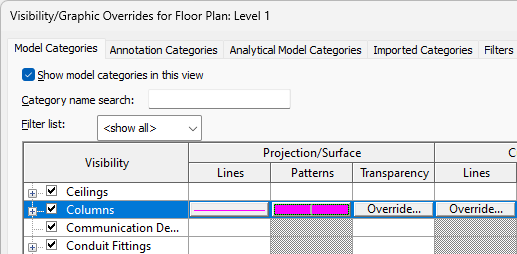Most overrides for visibility and graphic display are made in the Visibility/Graphics dialog. The exception is for individual element overrides; these are made in the View-Specific Element Graphics dialog.
From the Visibility/Graphics dialog, you can view overrides that have already been applied to a category. If the graphic display of a category has been overridden, the cell displays a preview of the graphic. If no overrides have been made to a category, the cell is blank, and the element displays as specified in the Object Styles dialog.
Example
In the following image, the Columns category has overrides for projection/surface lines and patterns.

For information on visibility settings for elements in linked models and elements in worksets, see Visibility of Linked Models and Change the Visibility of a Workset in a View.
Creating Views for Specific Purposes
Because you can control element visibility and graphic display by view, you can create views for specific purposes.
Some possibilities include:
- Furniture Layout—Show furniture half-toned on lighting RCP plan.
- Sprinkler Layout—Show sprinklers prominently on a half-toned ceiling plan.
- Furniture Plan—Show furniture and associated symbols, with room names and numbers, on a half-toned floor plan.
- Equipment Plan—As in an industrial kitchen layout: floor-mounted equipment shown prominently, wall-mounted equipment shown with an alternate line weight, and ceiling equipment (hoods) shown with a third line weight, on a half-toned power plan.
- Fire-Safety Plan—Show 1-hour, 2-hour, and other fire-rated enclosures on a half-toned floor plan in a manner so that you can distinguish the ratings. Overhead exit signs and sprinklers can appear in one color, and wall-mounted alarm devices and fire-extinguishers can appear in another color.
- Restoration Work—Show periods of existing materials in a building being reviewed for historic alterations. For example, 17th-century features shown in line weight 1, 18th-century features shown in line weight 2, and proposed alterations shown in line weight 3.
